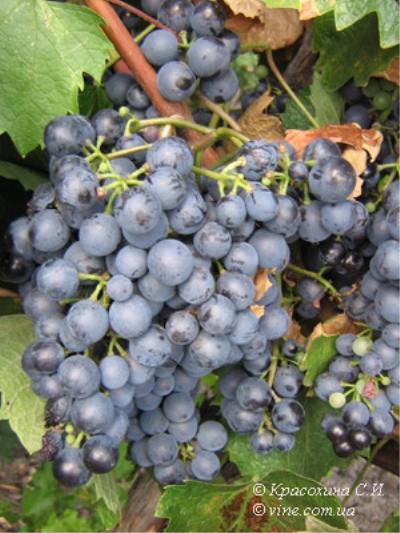
- Authors: VNIIViV them. ME AND. Potapenko, Russia
- Appointment: dining room
- Berry color: reddish purple
- Taste: simple
- Ripening period: early middle
- Frost resistance, ° C: -18
- Yield: 13.3-221.3 c / ha
- Flower type: bisexual
- Peeling: Yes
- Density of the bunch: medium density
The table variety of dark grapes Rodina is popular with gardeners, despite its whimsicality and demanding care. The variety is intended for fresh consumption and canning in the form of juices, compotes, preserves, jams.
Breeding history
Homeland is the result of the breeding work of Russian scientists VNIIViV named after V.I. Ya.I. Potapenko. To obtain a new hybrid with certain characteristics, the Severny and Muscat Aleksandriysky varieties were crossed, resulting in a high-yielding new hybrid variety intended for cultivation in Russia.
Geography of distribution
The variety is zoned for the southern and central regions of Russia, cultivated in the Far East.
Description
Medium-sized bushes give annual shoots, ripening by about 50-64% percent, of which up to 70% are fruitful. Shoots are covered with medium-sized, five-lobed, fine-cut leaves. The outer side of the leaf is matte and wrinkled, the wrong side is devoid of pubescence, has small bristles near the veins.
Ripening period
The hybrid belongs to the early-medium varieties, the approximate ripening period is 8-10 days later than the Chasselas grapes. Harvesting usually takes place in the first half of September.
Bunches
Medium-sized conical clusters weighing 190 to 380 grams have an average density. The fruits are prone to peas, if the overload of the bushes is allowed, the temperature regime is violated during flowering. The average brush size is 12-19 cm.
Berries
Rounded, medium-sized reddish-purple berries are covered with a firm, but thin skin, almost imperceptible when eaten. The weight of the fruit reaches 5 g. There are 2-3 seeds in the juicy pulp. Sugar content up to 18%, acidity in the region of 1%, soluble solids up to 18.5%. The fruits are rich in vitamin C - 20 mg per 100 g of the substance.
Taste
The tasting score of the Rodina variety is 8 points; the simple taste contains sour and sweet shades, which makes it harmonious.
Yield
The yield indicators of the hybrid are not stable - the hybrid is sensitive to weather conditions. Up to 7 kg can be harvested from one bush, but this is the declared fruiting - in unlucky years, the yield decreases sharply. In a good season, up to 220 centners are harvested per hectare, in a lean year they do not collect even 15 centners / ha.


Growing features
The hybrid variety is not too different from other varieties in agronomic techniques, except that it requires more attention to its own health and harvesting.
Landing
To get a strong and strong vine, there are a few rules to keep in mind. You should not take seedlings of this hybrid in the markets, in unverified retail outlets. This is best done in specialized nurseries, since the cuttings do not take root very well. Usually it is 50-72%. Sometimes the stalk will give roots, but it may bud. It is best to purchase seedlings with leaves, then you can see that the bush is alive. They are planted immediately after purchase, until the weak roots have dried.
For planting, they choose places protected from winds and drafts, the land should be fertile, breathable, without groundwater lying nearby. Planting pits must be arranged with a drainage layer, fertilized with complex mineral and organic fertilizers. The distance between the bushes is from 1.5 to 2 meters. In the early years, trunks or trenches should be loosened and weeded.

Pollination
Grape flower is bisexual. Flowering usually occurs in mid-June, around the 10th of the month.
Pruning
The bushes require annual sanitary pruning in the spring; in the fall, the vines are normalized, leaving 3-4 eyes.

Watering
Homeland belongs to table varieties, therefore it needs regular watering, but not more than 4 times during the growing season. This is done in early spring, with the beginning of sap flow, a week before flowering and a week after, during the ripening of the crop. More frequent watering is used only during dry periods.


Top dressing
For the normal development of the vine and full-fledged fruiting, the Motherland needs additional nutrients. For this, organic and mineral complex fertilizers are used.
Frost resistance and the need for shelter
The hybrid cannot boast of good frost resistance, only -18 degrees. In temperate climates, the vine must be covered, providing it with full protection from frost and soaking during thaws. Winter hardiness is influenced by factors such as overloading and the wrong harvest - delay has a negative effect on the vitality of the shoots.

Diseases and pests
The hybrid variety is susceptible to fungal diseases - mildew, oidium, anthracnose and others. It is not spared by pests and wasps. As a preventive measure, insecticides and fungicides, copper sulfate are used.

If a grape is exposed to any disease or insect, this always affects its appearance.
Storage
The homeland is characterized by poor transportability and low storage capacity. Bunches are stored in specially equipped refrigerating chambers for no more than 2-4 weeks.











































































